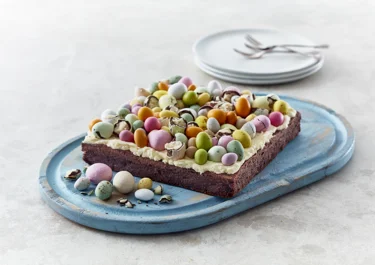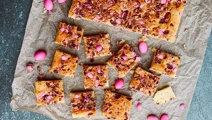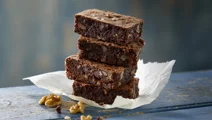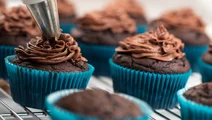
Easter brownie

Instructions
Brownie
Frosting
Decoration
Recommended information
Serving suggestion
Tips
Brownie is best when slightly underbaked, so you get that fudgy, gooey texture. Check the brownie a few minutes before the recommended baking time ends. It is done when you insert a toothpick into the centre, and it comes out with a few moist crumbs clinging to it. The residual heat will continue to cook it slightly once you remove it from the oven.
Tips
Avoid overmixing the batter once you add the flour and cocoa powder. Overmixing can develop the gluten in the flour, leading to a cake-like texture instead of the dense, fudgy texture that is characteristic of brownies.
Ingredients
Brownie
Butter or spreadable | 150 g |
|---|---|
Dark chocolate | 100 g |
Sugar | 300 g |
Eggs | 3 |
Vanilla sugar | 1 tsp |
Wheat flour | 120 g |
Cocoa powder | 40 g |
Salt | ¼ tsp |
Walnuts, roughly chopped | 50 g |
Frosting
Soft butter | 150 g |
|---|---|
Icing sugar | 175 g |
Vanilla sugar | 1½ tsp |
Cream cheese | 150 g |
Decoration
Easter Eggs in various sizes and colours |
|---|
Enjoy our Easter brownie for your festive celebrations
This Easter brownie is easy to make and ideal for any gathering with friends and family. Kids and adults alike will be tempted by the festive look, and as the easily sliced squares are perfect for a grab-and-go, it is a good choice for larger gatherings. With the Easter-inspired decorations on top, you will not think twice about making this for your Easter celebration, making sure everyone gets into that springtime Easter mood.
Crunchy walnuts and velvety cream cheese frosting
The cake offers a delicious balance of crunchy, chewy, and creamy. It has the characteristic gooey and chewy texture, but it is flanked by crunchy walnuts and a velvety cream cheese frosting, which elevates the overall eating experience. The frosting adds a delicate sweetness and an airy layer, while the walnuts in the batter add a rich, nutty, and slightly bitter flavour, balancing the dark chocolate in the best way possible.
A touch of Easter with decorative eggs on top
Classic chocolate brownies are always a hit, but decorate them with colourful eggs, and you get the perfect dessert for Easter. The differently coloured eggs, either whole or halved or maybe slightly crushed, add a fun, dynamic look to the cake. Nestled on the creamy frosting, they contrast the dark chocolate brownie and white frosting beautifully with their many colours and patterns.
Choose your favourite Easter eggs
Easter eggs come in many types, and you can use your absolute favourites on top of your Easter brownie. Chocolate Easter eggs are perhaps the most traditional and popular, ranging from solid chocolate to hollow eggs. They can be made from dark, milk, or white chocolate and are sometimes adorned with colourful wrappers or decorative icing. Marzipan Easter eggs are made from almond paste and are a treat for those who prefer a nutty flavour with extra sweetness. They can be plain or covered in chocolate and are sometimes beautifully painted or decorated with icing to mimic the appearance of real eggs. Creme-filled Easter eggs are a sweet indulgence, consisting of a thick chocolate shell encasing a soft, creamy filling that often mimics the yolk and white of a real egg. The filling can be plain, flavoured, or even include bits of other confections. For a more childish approach, you can opt for more untraditional Easter eggs such as jelly beans or the like. They come in a myriad of flavours, from fruity to sour, and they are sure to add a pop of colour to the cake. If you like the idea of using different Easter eggs as decoration, check our recipes for no-bake Easter cheesecake with lemon, a traditional Easter simnel cake, and eggnog cake. They are all decorated with various Easter eggs.
Make it your own
For an extra Easter twist, instead of only adding Easter eggs on top, consider adding them, crushed into different sizes, into the batter. This will give you a different experience with the Easter eggs, adding both crunch and flavour to the brownie. You can also customise the brownie by adding different nuts, such as pecans or almonds, or even mixing in chocolate chips or chunks for an extra chocolatey bite. As for the presentation, apart from Easter eggs, you can use edible glitter, chocolate shavings, or sprinkles that match the colours of the eggs to make your brownies extra festive.











